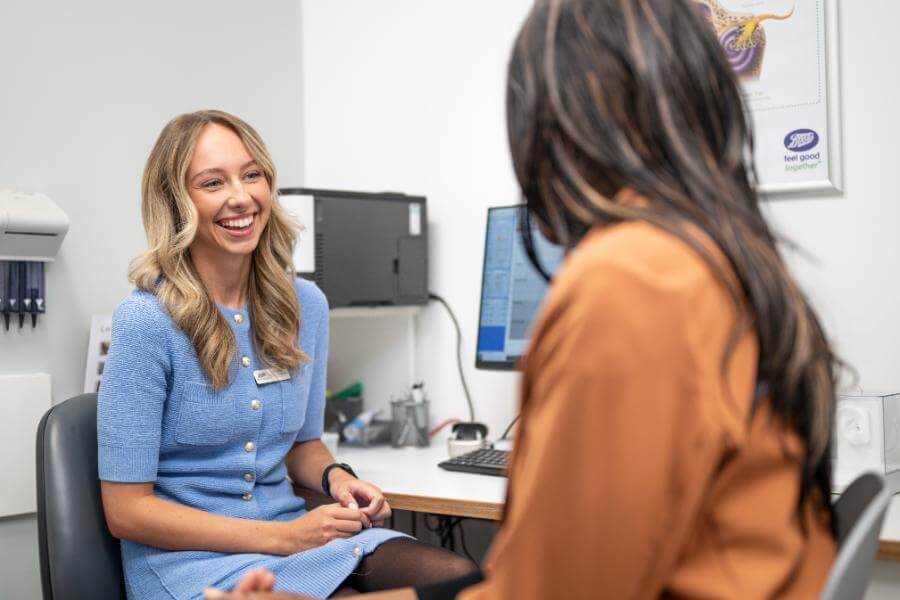Empowering connections: communicating with people with hearing loss

Empowering connections: communicating with people with hearing loss
5 minutes
Lifestyle 21 August 2025
21 August 2025
Clear, respectful communication plays a key role in connecting with people who are deaf or have hearing loss. It's not just about what we say - it's about how we listen, respond, and support with empathy, patience, and understanding.
If you're concerned about your own hearing, book a free adult hearing test to take the first step toward better understanding and communication.
Understanding hearing loss
Hearing loss affects people in different ways and can range from mild difficulties to profound hearing loss or deafness. Some individuals may be born with hearing loss, while others develop hearing loss gradually over time due to age, noise exposure, or medical conditions.
There are several types of hearing loss:
Sensorineural hearing loss: usually permanent, caused by damage to the inner ear or auditory nerve.
Conductive hearing loss: often temporary, caused by a blockage or issue in the outer or middle ear.
Mixed hearing loss: a combination of sensorineural and conductive hearing loss.
Profound deafness: where someone has very little or no hearing at all.
If you're curious about the causes and types of hearing conditions, take a look at hearing explained for a helpful overview.
People with hearing loss can face a range of communication challenges in everyday situations - whether it's following conversations in noisy places, hearing someone speak from a distance, or missing out on important sounds like doorbells or alarms. These difficulties can sometimes lead to feelings of isolation or frustration.
By understanding these challenges, we can be more mindful and supportive, helping to foster better communication and stronger relationships.
Building empathy and awareness
Empathy starts with truly listening - not just with our ears, but through our actions and intentions. For people who are deaf or living with hearing loss, everyday experiences can come with unexpected challenges. Simple conversations, group settings, or noisy environments can become sources of stress or exclusion.
By understanding these experiences, we can better appreciate how hearing loss affects more than just the ability to hear, it can also impact confidence, social connections, and emotional wellbeing.
Many people with hearing loss may feel isolated or misunderstood, particularly if others aren't aware of their condition. That's why raising awareness is so important. A thoughtful pause, making eye contact, or choosing a quieter space for a conversation can make a meaningful difference.
Small changes in how we communicate can go a long way in helping someone feel included, valued, and understood. It's about creating a world where everyone can connect comfortably, regardless of how they hear.
Effective communication techniques
Every individual with hearing loss is unique, and communication isn't one-size-fits-all. By adopting a few simple techniques, we can help make conversations clearer, more inclusive, and more comfortable for everyone.
Using clear speech
Speak at a natural pace and tone. Shouting or over-exaggerating your mouth movements can actually make it harder to understand, especially for lip readers.
Utilising visual cues
Facial expressions, gestures, and body language all play a vital role in communication. They help add context and emotion, supporting the meaning behind your words. Try to maintain eye contact and make sure your face is fully visible - avoid covering your mouth with your hands or speaking whilst eating. Good lighting and facing the person directly can also help.
Incorporate sign language
Learning a few everyday signs,such as greetings or questions,shows respect and makes conversations more inclusive. Even a small effort to learn a few key phrases shows you care and can make someone feel more included.
Use technology to your advantage
Many people use tools such as hearing aids, cochlear implants or apps with live captioning to help with communication. If you're new to this, living with hearing aids offers practical advice and insights on getting started. Be open to exploring these tools together, it shows you're committed to making communication easier.
Adapt to their communication needs
The most effective way to communicate is to ask what works best for them. Some people may prefer lip reading, others might write things down, use sign language, or rely on assistive tech. Be flexible, patient, and willing to adjust your approach. Every effort you make helps bridge the gap and fosters genuine, respectful connections.
Practical strategies for supportive relationships
Building strong connections with someone who has hearing loss starts with thoughtful actions and inclusive habits. These small, everyday choices can make a big difference, helping to create spaces where everyone feels respected and understood.
Creating an inclusive environment
An inclusive setting starts with the basics. Reducing background noise, such as turning down the TV or choosing quieter venues, can help conversations flow more easily. Good lighting is also essential, especially for those who rely on lip reading or visual cues. Whether at home, in social settings or at work, making these simple adjustments helps ensure everyone can participate fully.
You might also consider hearing protection to prevent further hearing damage, especially in loud environments.
Encouraging open communication
Some people may use sign language, lip reading, written notes, or prefer a mix. Being open and flexible helps build trust and confidence.
If you're unsure how to best support someone, it can be helpful to start with understanding your hearing and theirs.
Providing support and resources
This might include learning the basics of British Sign Language, sharing tips for assistive tech or simply pointing someone to professional advice. You can also explore helpful guides like tips for ear cleaning if you're wondering about how to clean ears safely.
In some cases, removing earwax can significantly improve hearing, so it's worth knowing when to seek expert help for earwax removal.
By learning, listening, and adapting how we connect, we can help build a more inclusive world, where everyone feels heard, understood, and supported.



